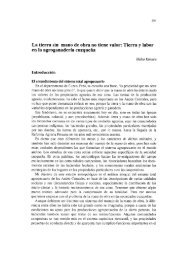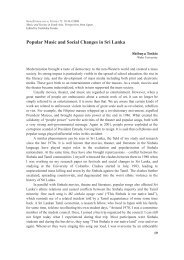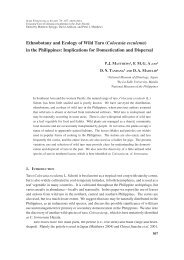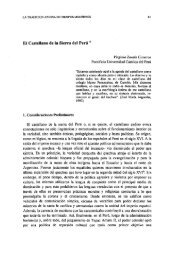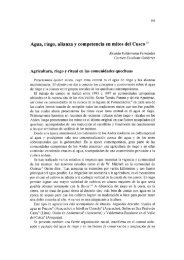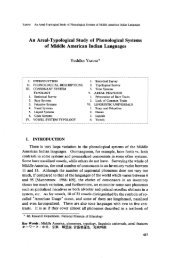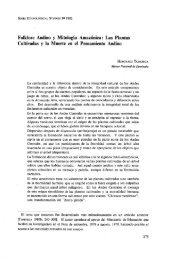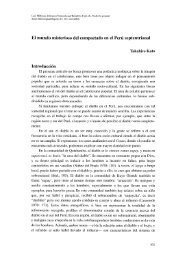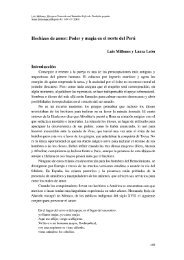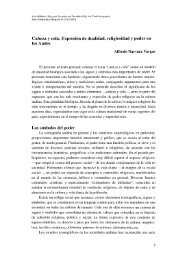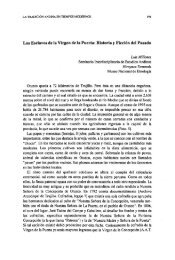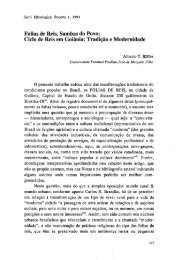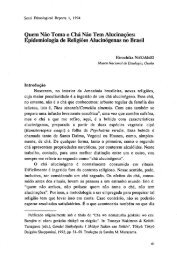The Sixteen Bodhisattvas in the Dharmadhatu ... - 国立民族学博物館
The Sixteen Bodhisattvas in the Dharmadhatu ... - 国立民族学博物館
The Sixteen Bodhisattvas in the Dharmadhatu ... - 国立民族学博物館
You also want an ePaper? Increase the reach of your titles
YUMPU automatically turns print PDFs into web optimized ePapers that Google loves.
Tachikawa <strong>The</strong> <strong>Sixteen</strong> <strong>Bodhisattvas</strong> <strong>in</strong> <strong>the</strong> <strong>Dharmadhatu</strong> Mandala<br />
construction is found on <strong>the</strong> vertical side of <strong>the</strong> larger plate, of which <strong>the</strong><br />
periphery is bent vertically. Even if <strong>the</strong> <strong>Dharmadhatu</strong> Manclala plate (Sva-M)<br />
is not <strong>the</strong> orig<strong>in</strong>al one, it is certa<strong>in</strong> that Sva-M is one of <strong>the</strong> most au<strong>the</strong>ntic<br />
materials for iconographic studies of <strong>the</strong> Newar Buddhist pan<strong>the</strong>on.<br />
3 <strong>The</strong> Symbols of <strong>the</strong> <strong>Sixteen</strong> <strong>Bodhisattvas</strong><br />
When Newar priests or artists depicted Buddhist deities, <strong>the</strong>y seem to have<br />
used a collection of late Indian Buddhist mandalas called <strong>the</strong> Nispannayogavali<br />
(NPY) as a text. This work, compiled and edited by Abhayakaragupta<br />
(11-12th century) , gives brief iconographical descriptions of deities appear<strong>in</strong>g<br />
<strong>in</strong> each of twenty six mandalas. It has been po<strong>in</strong>ted out that <strong>the</strong> symbols of <strong>the</strong><br />
Four Buddhas (Aksobhya, Ratnasambhava, Amitabha, and Amoghasiddhi)<br />
depicted on <strong>the</strong> struts of Chusya Bahal, Kathmandu, are <strong>in</strong> accordance with <strong>the</strong><br />
description given <strong>in</strong> <strong>the</strong> chapter on <strong>the</strong> <strong>Dharmadhatu</strong> Mandala of <strong>the</strong> NPY.6) It<br />
will be worth exam<strong>in</strong><strong>in</strong>g to what degree <strong>the</strong> images of <strong>the</strong> <strong>Sixteen</strong> <strong>Bodhisattvas</strong><br />
<strong>in</strong> <strong>the</strong> Kathandu Valley are <strong>in</strong> accordance with <strong>the</strong> description given <strong>in</strong> <strong>the</strong><br />
NPY.')<br />
(1) Samantabhadra<br />
All <strong>the</strong> five images of Samantabhadra found <strong>in</strong> <strong>the</strong> five places, i.e., Kva-C<br />
(Figure 10) , Uku-C (Figure 11) , Sva-C1 (Figure 12) , Sva-C2 (Figure 13) , and<br />
Sva-M (Figure 14) , have a sword stand<strong>in</strong>g on a water-lily (utpala) <strong>in</strong> <strong>the</strong> left<br />
hand, and a boon-giv<strong>in</strong>g gesture (varada-mudra) of <strong>the</strong> right hand respectively.<br />
<strong>The</strong>se two symbols accord with <strong>the</strong> description given <strong>in</strong> <strong>the</strong> chapter on<br />
<strong>the</strong> <strong>Dharmadhatu</strong> Mandala of <strong>the</strong> NPY.<br />
One can recognize <strong>the</strong> flower on which <strong>the</strong> sword is stand<strong>in</strong>g as a water-lily,<br />
because <strong>the</strong> petals of <strong>the</strong> flower found <strong>in</strong> <strong>the</strong> five places are not widely open,<br />
while <strong>the</strong> petals of a lotus flower are widely open like those of a sun-flower, as<br />
we see <strong>in</strong> <strong>the</strong> case of <strong>the</strong> Aksayamati image <strong>in</strong> Uku-C (Figure 16) .<br />
(2) Aksayamati<br />
Every image of Aksayamati found <strong>in</strong> <strong>the</strong> four places (Figures 16-19) o<strong>the</strong>r<br />
than Kva-C (Figure 15) , holds a sword <strong>in</strong> <strong>the</strong> right hand and a lotus flower <strong>in</strong><br />
<strong>the</strong> left hand. <strong>The</strong> NPY also states that Aksayamati has a sword and a lotus<br />
flower (padma) . <strong>The</strong> image <strong>in</strong>stalled <strong>in</strong> Kva-C has a sword <strong>in</strong> <strong>the</strong> right hand,<br />
and a kamandalu (a pot for holy water) <strong>in</strong> <strong>the</strong> left hand. It is likely that <strong>the</strong><br />
Sanskrit manuscript used for <strong>the</strong> construction of Kva-C had <strong>the</strong> render<strong>in</strong>g<br />
"k amandalu" <strong>in</strong>stead of "kamala."<br />
(3) Ksitigarbha<br />
All <strong>the</strong> five Ksitigarbha images have <strong>the</strong> same symbol <strong>in</strong> <strong>the</strong> left hand, that<br />
545



